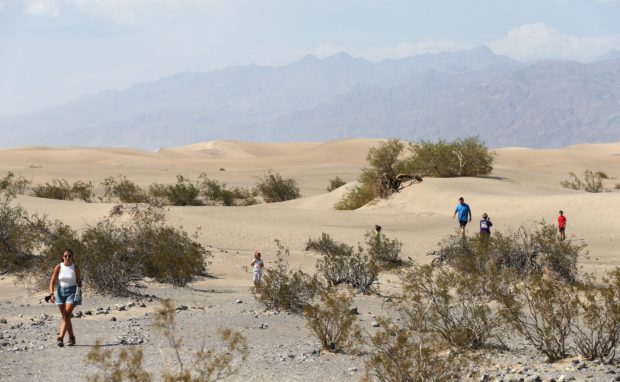
Visitors walk near the Mesquite Flat Sand Dunes on Aug. 17, 2020 in Death Valley National Park, California. Image: Mario Tama/Getty Images/AFP
A temperature of 130 degrees Fahrenheit (54.4 degrees Celsius) recorded in California’s Death Valley on Sunday by the U.S. National Weather Service could be the hottest ever measured with modern instruments, officials say.
The reading was registered at 3:41 pm at the Furnace Creek Visitor Center in the Death Valley national park by an automated observation system — an electronic thermometer encased inside a box in the shade.
In 1913, a weather station half an hour’s walk away recorded what officially remains the world record of 134 degrees Fahrenheit (56.7 degrees Celsius).
But its validity has been disputed for a number of reasons: regional weather stations at the time didn’t report an exceptional heatwave, and there were questions around the researcher’s competence.
The next highest temperature was set in July 1931 in Kebili, Tunisia, at 131 degrees Fahrenheit (55.0 degrees Celsius) — but again, the accuracy of older instruments has been questioned.
In 2016 and 2017, weather stations in Mitribah, Kuwait and Turbat, Pakistan recorded temperatures of 129.2 degrees Fahrenheit (54 degrees Celsius). After evaluation by the World Meteorological Organization both were downgraded by a few fractions of a degree.
The Geneva-based World Meteorological Organization said Monday it would start verifying the new US reading.
“This observed high temperature is considered preliminary and not yet official,” said the US National Weather Service.
‘On the fence’
Dan Berc, an official at the Las Vegas NWS office responsible for the site, told AFP that the sensor would be brought in for evaluation.
The investigation would take “at least a couple of months,” he said, adding: “Growing up as a kid, I thought 130 degrees Fahrenheit was a really cool record.”
A visitor takes a photo in front of an unofficial thermometer at Furnace Creek Visitor Center on Aug. 17, 2020 in Death Valley National Park, California. Image: Mario Tama/Getty Images/AFP
Validation isn’t a formality, and long-held records have been thrown out after modern evaluation.
For decades, the heat record was officially the 136.4 degrees Fahrenheit (58 degrees Celsius) recorded in 1922 in El Azizia, now modern Libya.
But a WMO panel that investigated it in detail between 2010 and 2012 stripped it of the title after finding multiple troubling aspects, including a potential problem with the thermometers and an inexperienced observer.
Weather historian Chris Burt, who conducted an analysis in 2016 that disputed the 1913 record, said the meteorological community was “on the fence” about whether the new record was real.
“The suspicion about yesterday is that normally… all the stations are also reporting record high temperatures at the same time, and yesterday that wasn’t the case,” he told AFP.
Las Vegas, for example, only recorded 113 degrees Fahrenheit (45 degrees Celsius).
On the other hand, he said, a tropical storm off the coast of the Baja California Peninsula had left a deep plume of moisture over much of California, which has resulted in large thunderstorms and localized heat surges.
“There was also a lot of convection in the mountains just west of Death Valley so there could have been some kind of effect downslope into Death Valley that really pushed up the temperatures,” he added.
Global warming
The southwestern United States is currently enduring an intense heat wave. Scientists say such waves are becoming more frequent and dangerous because of human-driven climate change.
Worldwide, the five hottest years in history have occurred in the last five years.
Under the 2015 Paris Agreement, nations committed to limit temperature rises to “well below” two degrees Celsius (3.6 Fahrenheit) above pre-industrial levels, mainly through sweeping emissions cuts.
These goals are seen as crucial to avoid triggering a series of tipping points that would cause irreversible global heating by the end of the century, making vast swaths of the planet inhospitable for life.
Michael Mann, a climate science professor at Pennsylvania State University, said: “As the planet continues to warm, it is inevitable that we will continue to see records fall.”
If the new reading is confirmed, then “that record too shall fall soon enough,” he added. NVG
RELATED STORIES:
Temperature spike: Earth ties record high heat May reading
Has the lockdown inspired new hope in the fight against global warming?